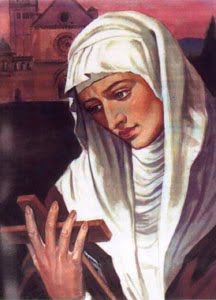
Feastday: November 16
Birth: 1198
Death: 1253
Agnes was born in Assisi. She was the younger sister of St. Clare. At fifteen she joined Clare at the Benedictine convent of Sant'Angelo di Panzo. Determined to follow her sister's life of poverty and penance, she resisted her relatives' attempts to force her to return home, and was given the habit by St. Francis and sent to San Damiano with Clare, thus founding the Poor Clares. St. Francis appointed her abbess of the Poor Clares' convent at Monticelli near Florence in 1219. She established convents at Mantua, Venice, and Padua, and supported her sister's struggle for poverty in their Order. Agnes was with Clare at her death and died three months later, on November 16, reportedly as predicted by Clare. Many miracles have been reported at her tomb in Santa Chiara Church in Assisi. November
Christian saintAgnes of Assisi (1197 or 1198 – 16 November 1253) was a younger sister of Clare of Assisi and one of the first abbesses of the Order of Poor Ladies (now the Poor Clares).
Life
She was a younger daughter of Count Favorino Scifi. Her birth name was probably Caterina; she took the name of Agnes when she became a nun. Her mother, Ortolana, who also would join the order founded by her daughters, belonged to the noble family of the Fiumi. Their cousin Rufino Scifi was one of the original "Three Companions" of Francis of Assisi. Agnes spent her childhood between her father's palace in the city and his castle of Sasso Rosso on Mount Subasio.
On 18 March 1212, her eldest sister Clare, inspired by the example of Francis of Assisi, left their father's home in secret to become a follower of Francis. Sixteen days later, Agnes ran off to the Church of St. Angelo di Panzo where Francis had brought her sister, resolved to share Clare's life of poverty and penance. Angry at the loss of two of his daughters, their father sent his brother Monaldo and several relatives and armed followers to the monastery to force Agnes, if persuasion failed, to return home.
 Arrival of Saint Agnes of Assisi at the Convent, António de Oliveira Bernardes, 1697
Arrival of Saint Agnes of Assisi at the Convent, António de Oliveira Bernardes, 1697
Monaldo drew his sword to strike his niece, but his arm allegedly dropped to his side, withered and useless. The others dragged Agnes out of the monastery by her hair, striking and kicking her repeatedly. Agnes' body reportedly became so heavy, perhaps due to the help of her sister, that her assailants dropped her in a field nearby. Agnes' relatives, purportedly realizing that something divine protected her, allowed the sisters to remain together. Francis himself cut her hair and gave her the religious habit, in recognition of Agnes' dedication.
Francis later established a cloister for Clare and Agnes at the rural chapel of San Damiano, where they were soon joined by other noblewomen of the city, and the Order of Poor Ladies, later known as the Poor Clares, began, with Clare as its abbess. In 1221, a group of Benedictine nuns in Monticelli near Florence asked to become Poor Ladies. Agnes was chosen to lead the new community. Although life in the Florentine convent was harmonious and without faction, she missed her sister greatly.
She later went on to establish other communities of the order, including those of Mantua, Venice, and Padua. Agnes was said to be very virtuous, and as abbess she ruled with a benevolent kindness, knowing how to make the practice of virtue appealing to her sisters.
In 1253, Agnes returned to Assisi to nurse her sister Clare during the latter's illness, and shortly thereafter died herself, on 16 November 1253. Her remains were interred with those of her sister at the Basilica of St. Clare at Assisi.
Agnes' feast day is the anniversary of her death, 16 November.
Notes
- ^ Robinson, Paschal. "St. Agnes of Assisi." The Catholic Encyclopedia Vol. 1. New York: Robert Appleton Company, 1907. 6 January 2020
 This article incorporates text from this source, which is in the public domain.
This article incorporates text from this source, which is in the public domain.
- ^ Arnald of Sarrant. Chronicle of the Twenty-Four Generals of the Order of Friars Minor, (Noel Muscat ofm, trans.) Ordo Fratrum Minorum. Malta, 2010
- ^ Foley O.F.M., Leonard. "St. Agnes of Assisi", Saint of the Day, Franciscan Media
- ^ "Agnes of Assisi", SAints Resource, RCL Benziger
- ^ Monks of Ramsgate. “Agnes of Assisi”. Book of Saints, 1921. CatholicSaints.Info. 13 May 2012
 This article incorporates text from this source, which is in the public domain.
This article incorporates text from this source, which is in the public domain.
- ^ “Saint Agnes of Assisi”. New Catholic Dictionary. CatholicSaints.Info. 28 July 2012
![]() This article incorporates text from a publication now in the public domain: Herbermann, Charles, ed. (1913). "St. Agnes of Assisi". Catholic Encyclopedia. New York: Robert Appleton Company.
This article incorporates text from a publication now in the public domain: Herbermann, Charles, ed. (1913). "St. Agnes of Assisi". Catholic Encyclopedia. New York: Robert Appleton Company.
 Saints portal
Saints portal





